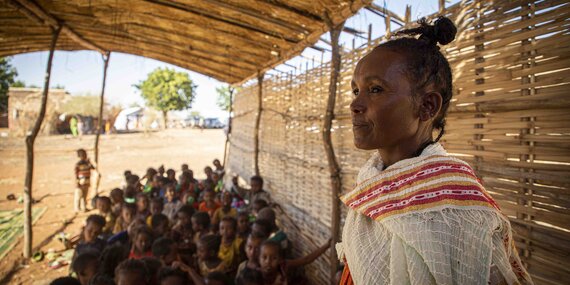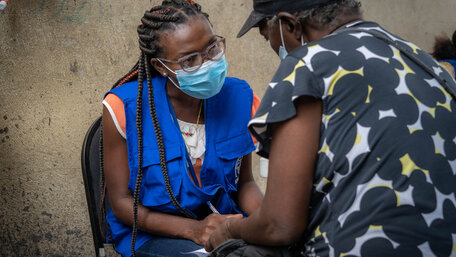Al Qadarif, Sudan
This woman is one of the Ethiopian refugees who volunteered to teach children in makeshift classrooms at Um Rakuba camp, Al Qadarif, Sudan. She said: "These children are the next generation coming up. Some will be doctors, teachers, pilots. I don't just dream for them … teaching plays a role in building a generation.” Clashes between the Ethiopian army and forces from the Tigray region have driven thousands of people to flee their homes – more than half of them are children. Since the fighting began in early November 2020, Ethiopian refugees have fled into Sudan to find safety. The majority have crossed at Hamdayet border point in Kassala state and others at Lugdi in Gedaref state. UNHCR and humanitarian partners have relocated new arrivals to a site in Um Rakuba, where they can access shelter, food, water and medicine. Volunteer teachers have mobilized to create a schedule and curriculum, and the school now has over 1,200 pupils. UNHCR/Will Swanson
Part one: Global trends
COVID-19 shows no signs of abating, claiming at least 1.8 million lives across the GHO countries, fuelled by variants and a lack of vaccines. Economies and livelihoods have been devastated, increasing humanitarian needs and fuelling conflict. Only 4 per cent of the 7 billion vaccines administered have reached countries with an HRP. In two thirds of these countries, an additional 20 million people have been pushed into extreme poverty.
Major tipping points for the climate may already have been reached or passed; humanitarian action must adapt. Climate-related disaster events are more frequent and variable. Up to 216 million people may have to move within their own countries by 2050 due to the effects of climate change.
Political conflicts continue hitting civilian populations hard, particularly the vulnerable including children and persons with disabilities. Women and girls remain at increased risk of conflict-related sexual violence. Attacks against humanitarian workers and assets continue; 117 humanitarian workers were killed in 2020, 108 of whom were working in their own country.
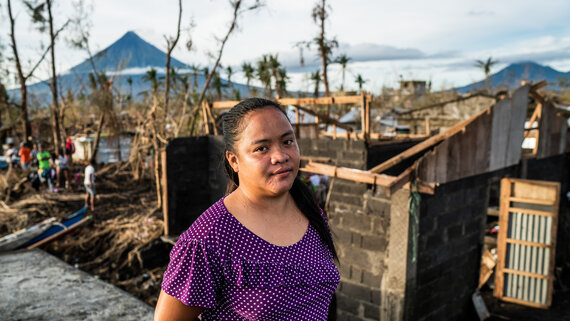
Barangay Baybay, Philippines
A woman in front of her destroyed house, a week after Super Typhoon Goni battered the area. Goni made landfall in this province, destroying most houses in the coastal communities.
OCHA/Martin San DiegoMore than 1 per cent of the world’s population is now displaced, about 42 per cent of whom are children. Millions of IDPs are living in protracted situations, 40 per cent fewer are able to return home.
COVID-19 is severely impacting health systems worldwide. Testing, diagnosis and treatment have decreased for HIV, TB and malaria. Antenatal-care visits have fallen by 43 per cent and 23 million children worldwide missed basic childhood vaccines in 2021.
Hard-won development gains in employment, food security, education and health care have been reversed. Extreme poverty is rising after two decades in decline. Recovery from the extraordinary disruptions caused by COVID-19 remains uncertain. Women and younger workers are disproportionately impacted by job losses.
Hunger is rising and food insecurity is at unprecedented levels. Globally, up to 811 million people are undernourished. Famine-like conditions remain a real and terrifying possibility in 43 countries around the world. Without sustained and immediate action, 2022 could be catastrophic.
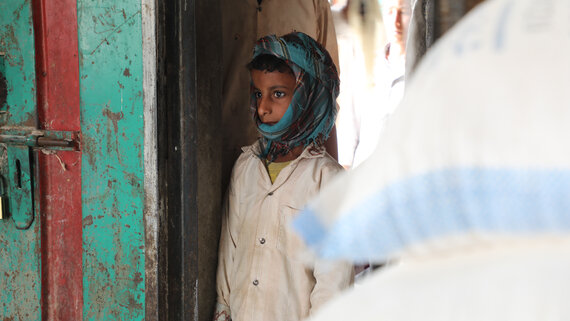
Al Noeyah, Yemen
A boy waits at the food distribution point supported by WFP.
WFP/Ayman FuadCOVID-19 continues to disrupt global education. School closures hit vulnerable children the hardest. Globally, 870 million students face disruptions to their education. Remote learning cannot reach everyone; 2.2 billion children have no Internet access at home. Online learning does not replace the benefits of children physically being in school.
The pandemic has dealt a major blow to gender parity and women’s employment. The gender-poverty gap is widening, and 247 million women live on less than US$1.90 a day. For every three months that COVID-19 lockdowns continue, an additional 15 million GBV cases are expected to occur. Women and girls living in humanitarian contexts are experiencing GBV at a disproportionate rate.
The private sector has been a key ally during COVID-19, demonstrating its ability to mobilize resources and strengthen emergency preparedness and recovery. Greater collaboration is needed to systematically include the private sector in humanitarian coordination systems.
Part two: Inter-agency coordinated appeals
In 2022, 274 million people will need humanitarian assistance and protection - a significant increase from 235 million people a year ago, which was already the highest figure in decades. The UN and partner organizations aim to assist 183 million people most in need across 63 countries, which will require US$41 billion.
The ten most underfunded emergency situations in 2021 received less than half the funding required to meet humanitarian needs. Humanitarian aid cannot provide a path out of protracted crises while such a scarcity of funds persists. Much-needed food rations have been cut back and life-saving health-care services reduced. It is essential that funding requirements for 2022 are met in full and on time.
Two regions (the Middle East and North Africa and West and Central Africa) continue to have the most humanitarian needs due to protracted crises that show no signs of abating. Over the past two years, sharp increases in needs are evident in Asia and the Pacific, Latin America and the Caribbean, and Southern and East Africa. Five years ago, only Haiti had an HRP in Latin America and the Caribbean, now there are six in place across the region.
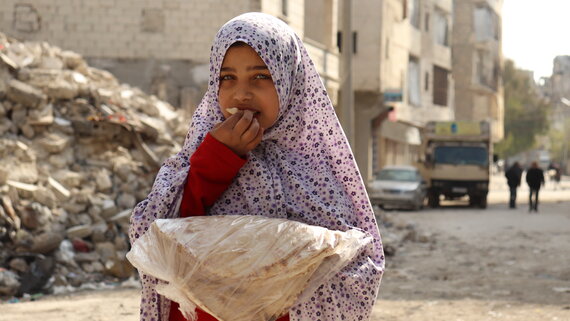
Aleppo, Syria
Around 2,000 households received bread and COVID-19 information flyers in Salheen, a poor neighborhood in Aleppo. The neighbourhood was under opposition control until late 2016 and the massive destruction of buildings is still visible. Residents relied on daily or weekly wages, which have been halted due to precautionary measures for COVID-19.
WFP/Khudr AlissaIn Afghanistan, more than 24 million people require life-saving assistance to prevent catastrophe. This represents a dramatic increase in needs, driven by repeated economic shocks, political tumult and the severe food insecurity caused by the worst drought in 27 years.
A decade into the crisis in Syria and basic service delivery continues to be vastly inadequate and hampered by damaged infrastructure, lack of critical supplies and, increasingly, financial unaffordability. Average household expenditure now exceeds available income by 50 per cent compared to 20 per cent in August 2020.
Despite continued efforts to mitigate the risk of famine in Yemen, food insecurity continues to remain a key challenge. Acute food insecurity is a reality for 16.2 million people in the country. Even with the current levels of humanitarian assistance, 40 per cent of the population have inadequate food.
In Ethiopia, climate shocks, unprecedented levels of conflict, insecurity and disease outbreaks coupled with a deteriorating economy continue to exacerbate humanitarian needs for 25.9 million people. Many of the 4.2 million IDPs, seek shelter in urban areas, further increasing pressure on vulnerable families within host communities.
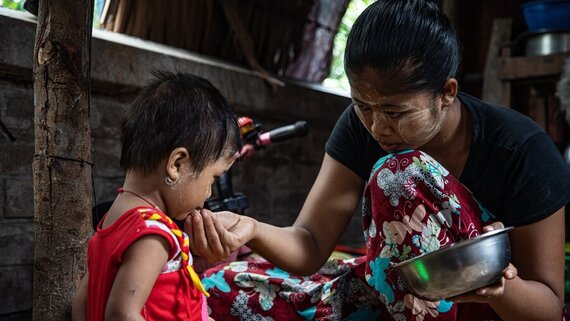
Yangon, Myanmar
This woman lives in the urban outskirts of Yangon. Since February, food prices have been rising throughout Myanmar, placing basic foods out of the reach of the poorest people. The price of cooking oil has risen 47 per cent while rice is up almost 20 per cent on the same period last year. The current political crisis and the COVID-19 pandemic have exacerbated job cuts and resulted in lost incomes.
WFP/PhotolibraryPeople in Myanmar are facing an unprecedented political, human rights and humanitarian crisis, with needs escalating dramatically since the military takeover and a severe COVID-19 third wave in 2021. Humanitarian assistance is needed by 14.4 million people.
In Haiti, 43 per cent of the population needs humanitarian assistance. The country is experiencing a profound and disturbing deterioration of the socioeconomic, political and security context coupled with the effects of the pandemic and a 7.2-magnitude earthquake that affected more than 800,000 people.
South Sudan is facing its highest levels of food insecurity and malnutrition since the country declared independence 10 years ago. Macroeconomic shocks, three years of consecutive flooding, disease outbreaks and increasing subnational violence have resulted in 8.4 million people in need and a growing number of threats against humanitarian workers
Part three: Delivering better
Enhanced data collection is helping address the specific needs of women and girls in humanitarian prioritization and response. More women are needed in humanitarian leadership roles. Lack of funding for GBV response, mitigation and prevention remains of critical concern.
CERF and the CBPFs continue to reach the most vulnerable people, prioritizing response, recovery and coordination for extreme weather events, conflicts, disease outbreaks and the impacts of COVID-19.
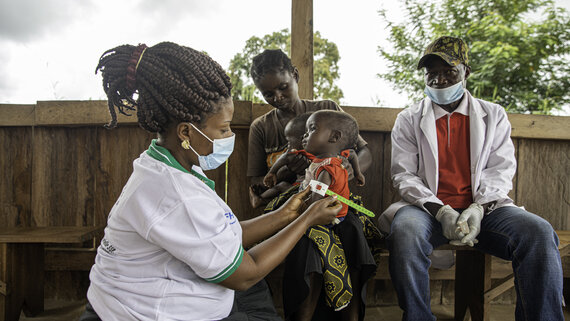
Nyunzu, DR Congo
This internally displaced woman regularly brings her twins to the Tchanga Tchanga health centre to monitor their nutritional status. With funding from the DRC Humanitarian Fund, Médecins d'Afrique cares for some 3,450 children under 5 years of age suffering from severe acute malnutrition in Nyunzu.
OCHA/Wassy KambaleAt a time when 45 million people are on the edge of famine, the High-Level Task Force on Preventing Famine is actively advocating for famine prevention resources, improved access to people in need and strengthened data and analysis. Without immediate and sustained action to prevent famine, humanitarian needs will far exceed those seen in the last decade.
As new and escalating crises emerge, progress has been made on strengthening system- wide accountability to affected people and protection from sexual exploitation and abuse.
Local leaders and communities are gaining greater recognition by international actors as key first responders in a crisis and providers of long-term support. They have been critical to sustaining humanitarian operations and being at the forefront of the COVID-19 response.
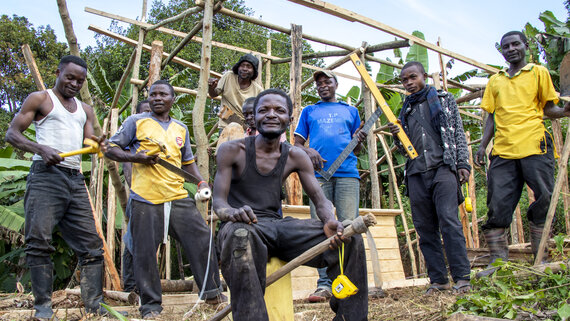
Kalunguta, DR Congo
This man is building a house for his family, together with nine other displaced men. In turn, he will help them to construct their homes. He says: "There was intense fighting where we lived. People were killed. That's how we fled here. I've spent one year here now. We help out people in the fields in exchange for a little flour and oil. They gave us some cooking utensils because we had to leave everything behind. We are really thankful for their help. Now they even gave us these plots. Here we feel at peace. Today we are building the house for my family. We work together, 10 people from the neighbourhood, all the way to the top. When we finish one house, we start building the next, and so on. We also work with the local people, youths and women who we met here. They show solidarity with us who are displaced."
OCHA/Ivo BrandauHurricanes Eta and Iota demonstrated local humanitarian organizations’ pivotal role in saving lives while dealing with a pandemic. Local partners directly responded to affected communities in Guatemala and Honduras and informed operational planning. Essential first-hand knowledge of affected communities enabled timely and appropriate responses.
An estimated half of all today’s crises are somewhat predictable. Anticipatory action mitigates the shock impact and reduces humanitarian needs, helping to enhance resilience and making resources more efficient.

